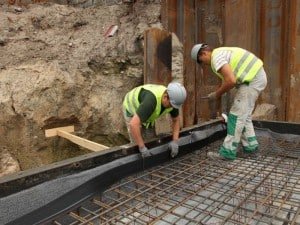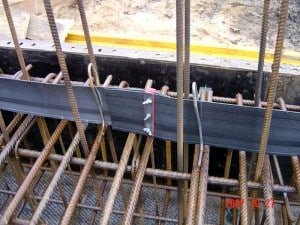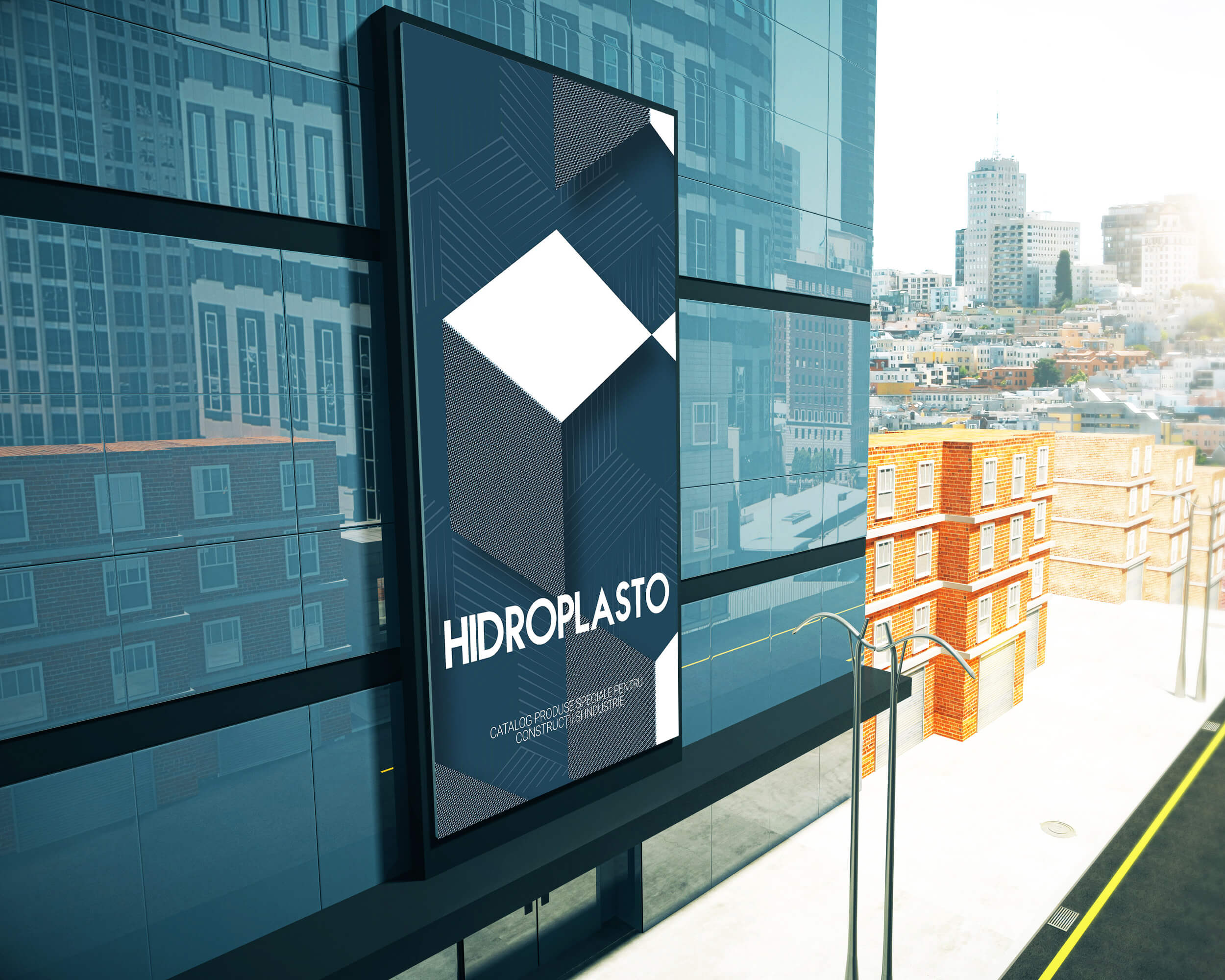1. Item tested and scope
1.1 Item tested
The KAB combined waterproofing profile is a black stripe product made of vinyl polyvinyl chloride (PVC-P). The waterproofing profile has a continuous profiled structure. It is available at heights of 125 mm or 150 mm and contains a red embedded hydrophilic seal at the base (appendix 1).
1.2 Scope
The waterproofing profile of normal flammability corresponds to the List of Rules and Standards in Construction A, part 2, no. 1.4 (modified later). It is used to seal in-situ concrete joints with increased resistance to water penetration by pressure, a pressure of 2.0 bar (corresponds to a depth of 20 m).
The waterproofing profile can be used in areas where the water level changes frequently. The waterproofing profile complies with class A usage requirements for voltage classes 1 and 2 as prescribed by the Waterproofing Structure Rules (WU-Richtlinie).
The waterproofing profile shall be applied as specified in sections 2.3 (product details).
2. Requirements imposed on the combined KAB waterproofing profile
2.1 Characteristic Properties and Values
The construction product has the characteristic values shown in Table 1, and must be in accordance with these values.
The waterproofing profile is suitable for use as demonstrated in tests performed according to test principles for sealing joints in concrete elements with increased resistance to water penetration by pressure or pressure and against soil moisture; status: May 2008 (Test Report No. 2010-001 of Fachhochschule Dortmund and Testing Report No. 5097/533/10 of MPA Braunschweig).
Construction joints that are sealing with waterproofing profiles:
• Provides adequate stability,
• Provides adequate grip strength,
• Waterproof,
• Provides adequate aging resistance
For the scope mentioned in section 1.2 above.
The construction product is in accordance with the requirements of building materials class B2 according to DIN 4102-1.
2.2 Packaging, transport, storage and identification
The waterproofing profile must be packed, handled and stored in such a way that its intended properties are not adversely affected. The instructions given by the manufacturer must be followed.
The construction product must be marked with the product name, the conformity mark (see section 4 below), the name of the manufacturer, the date of manufacture, the GefStoffV Dangerous Substance (if applicable) and the number series.
2.3 Product Details
With respect to the product and plant details, the planning principles for the waterproofing profiles of DIN V 18197 (section 5) and the manufacturer’s installation instructions (Annexes 2 and 3), which have been checked for compliance with the initial type test results, are applied by analogy.
The normal position of the waterproofing profiles is in the middle of the construction joint. The waterproofing profile must be recessed at least 2.5 cm and not more than 5 cm in the foundation concrete. A minimum distance of 8 cm must be kept from the end of each element.
Steps must be taken to prevent the waterproofing profile from moving or floating when casting the concrete.
3. Declaration of conformity
3.1 Generalities
Confirmation that the above waterproofing profile complies with the requirements stated in the General Construction Test Certificate will be provided for each plant in the form of the manufacturer’s declaration of conformity. The declaration will be issued on the basis of factory production control (CPF) and on the basis of the initial type test for the product, which is executed by an authorized inspection commission.
3.2 Type Test
An initial type test is not required because the test samples were taken from the factory production process as part of the use correspondence certification. If the manufacturing conditions of the product change, then an initial type test must be carried out by an inspection commission authorized by the construction supervisors.
For the initial type test, the characteristic values must be verified based on Table 1. The values obtained must not differ from the reference values beyond the tolerances shown in this table.
3.3 Factory Production Control (CPF)
A production control program at the factory must be set up and carried out at each factory in accordance with DIN 18200.
The factory production control shall be carried out in accordance with the specifications given in Table 1, reflecting the special features of the product and the manufacturing conditions for these products. The requirements are based on the results of the initial test.
The results of the factory production control must be kept and evaluated by the manufacturer.
Records must include at least the following details:
• Product name,
• Type of test or inspection,
• Date of manufacture or test date,
• Test results and comparison with requirements,
• Signature of the person responsible for factory production control.
Records must be kept for at least five years and must be submitted on request.
If the test results in inappropriate results, the manufacturer must take immediate action to address the reported deficiencies. Non-compliant construction products must be handled to prevent confusion with conforming and defective products. After correcting the deficiencies, the test should be repeated to show the correct correction.
Properties Test conditions Frequency Requirements
Waterproofing profile
Inspection of source materials – Per delivery batch No signs of change
General features DIN 18541-2
section 4.2 Per production lot No bubbles, cracks and shrinkage cavities
Dimensional stability DIN 18541-2
section 4.3 Per production lot Dimensions according to Annex 1
± 10%
SHORE Hardness DIN 18541-2
section 4.4 Per production batch (90 ± 5) Shore A after 3 seconds
Tensile strength DIN 18541-2
section 4.5 Per production batch k ≥ 9.0 MPa
Elongation at break DIN 18541-2
section 4.5 Per production batch k ≥ 230%
Weldability DIN 18541-2
Section 4.12 Per production week f ≥ 0.6
Rubber swelling
Inspection of source materials – Per delivery batch No signs of change
General characteristics – Production per batch No bubbles, cracks and shrinkage cavities
Dimensional Stability – Per Production Lot Ø: x = 5.2 mm ± 10%
Capacity to inflate (weight gain) 14 days in distilled water Per production batch x = 471% ± 10%
k = lowest individual value f = thickening factor x = average value
4. The conformity mark
The construction product must be marked by the manufacturer, using the conformity mark (“U” mark) in accordance with Federal State compliance marking regulations. The conformity mark must also be printed on the packaging with all the details required.
5. Legal basis
The General Construction Test Certificate (abP) is issued under Articles 25a et seq. Of the Lower Saxony Construction Code (NbauO) in connection with the List of Rules and Standards in Construction A, Part 2, no. 1.4 (as subsequently amended).
6. General Mentions
6.1 The General Construction Test Certificate (abP) shall not be construed as replacing any of the building permits, permits and certificates required by law for the execution of construction projects.
6.2 The General Construction Test Certificate (abP) is issued without prejudice to the rights of third parties, in particular, the rights of private property.
6.3 The Contractor shall keep the General Construction Test Certificate (abP) with all execution details (installation instructions) available on site.
6.4 The general construction test certificate (abP) can only be copied as full text. Extracts from the Certificate may be published only with the prior permission of the inspection committee that issued the Certificate. The wording and drawings used in promotional brochures must not conflict with the contents of the General Construction Test Certificate. Translations of the General Construction Test Certificate will be marked “translation” of the original in German, not verified by the Braunschweig Institute of Materials Testing.
6.5 The General Construction Test Certificate (abP) may be revoked. The provisions of the General Construction Test Certificate (abP) may be modified or revised later, especially if and when required as a result of new technical discoveries.





